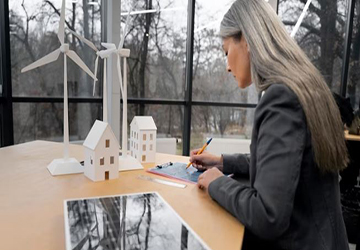Top 10 Tips for Environmental Protection
Climate change is one of the substantial challenges we are facing as humans. The varying weather is quite unusual at certain times of the year, creating havoc these days. It is no surprise we are on the brink of an environmental disaster. But why is this happening? We are told that it is not too late, and there are chances to minimize the damage, but how? The answer is simple, reduce your carbon footprint.
If you are not an environmentalist, the term carbon footprint may sound unnatural. The combined amount of greenhouse gases are released into the atmosphere, resulting from industrial emissions and individual, national, or organizational actions. Moreover, these greenhouse gasses will increase with time if we do not reverse our steps.
But how to reduce the carbon footprint? What intelligent choices can contribute to less emissions? If you are also seeking an answer, read along to learn more.

Reduce your carbon footprint: Home Energy.
Change begins at home. You can lessen your carbon footprint by following these quick and simple steps, which means you can start living an eco-friendly life instantly.
Insulate your home
Heating your home is expensive and consumes most of the electricity units. You can insulate your whole house, including the loft, which can retain heat during winter and stay cool during the summer. It means you will use less energy, reducing energy bills by saving units and creating fewer carbon footprints.
Save water
People generally waste a lot of water, especially in the summertime, to beat the heat. But only some people know that providing for your house takes a lot of energy. Here you can turn off water taps while brushing or shaving. At the same time, you can have short baths and boil water when needed. This way, you can save energy and have a less intense process at the back.
Dietary habits
Now it may sound unreal, but our food significantly impacts the environment. For example, farming meat and dairy products require much land and energy, producing methane as a greenhouse gas. Moreover, much food is imported, which requires resources to run.
Now either shift to plant-based foods or find other ways to save energy using fewer resources to protect the environment.
Buy energy-efficient items
Everyone needs electrical appliances for daily use, but we can constantly shift towards energy-efficient appliances such as energy-saving light bulbs. Alternatively, you can do this with your fridge, TV, and other devices or change to solar panels.
Reduce Traveling
Whenever possible, either walk or take a bike to avoid emissions. Moreover, you can carpool to work. This way, you can avoid traffic, and fewer vehicles will be on the road.
Even if you need to drive, you can choose a low-carbon vehicle. Another option is to go for electric cars or vehicles with solar panels, which are nature friendly. I will save gas and will cost a fortune less compared to other choices.
Additionally, do not overspend; it will increase acceleration, reduce mileage, and increase gas use.
Lastly, combine errands to make fewer trips, and it will remove the access load from your vehicle.

Reduce carbon footprint: At work.
Nowadays, many companies have energy-efficient policies at work. The more you save, the more you care. You can achieve the target by following these simple steps at work.
1. Switch off the lights and fans whenever you leave the room. You can do the same with your desk lights, save energy, and reduce your carbon footprint.
2. You can turn off appliances and machines in the office. Turn off photocopier machines and scanners which are not in use.
3. Install automatic sensor lights for walking.
4. Buy LED bulbs for multiple benefits.
5. You can now store all documents online. It will save energy consumption by cutting fewer trees.
6. Do online meetings and conferences.
You can start very small, but it will make a difference in the long run.
Use Clean Energy
Humans are burning fossil fuels to create energy worldwide, producing high amounts of greenhouse gases. We must shift towards renewable energy resources if we want to preserve the future. Here are a few alternatives and benefits of using wind, water, and sun to produce energy and reduce carbon footprint.
Abundant sources
Renewable energy is all around us. Although the potential is yet to be entirely harvested, you can use sun, water, and wind energy everywhere in the world. Few areas may not sun round the year but generate the same from water and wind.
Save finances
Once you install the renewable energy plant, there will be much less upkeep expense. It does not need any coal or gas to run the plant, which means a clean environment.
Industrial change
As much as individuals are responsible, industries are also accountable for environmental change. The smoke they emit and the trash they throw, including toxic waste, a biohazard and instantly destroy nature. Other industries, such as mining and drilling, also leave a lot of dust.
To curtail this, industries must become eco-friendly. Or at least some of their practices to begin with. First, they must use renewable energy resources at all leaps and bounds to reduce smoke, and they can install their energy panels and become off-grid.
Next is to reduce and recycle industrial waste. Almost all waste can be reused adequately if separated; for example, threads from the cotton industry can be sent to home-based shops or dealers.
Be smart about what you choose. Saving the environment is in our hands, and reducing our carbon footprint is the top priority. Remember, it is done in tandem, so measure where you are currently and identify improvement areas.
You can also vouch for forestry projects and contribute in any way possible. It will reduce carbon footprint shortly and will benefit the upcoming generation.











